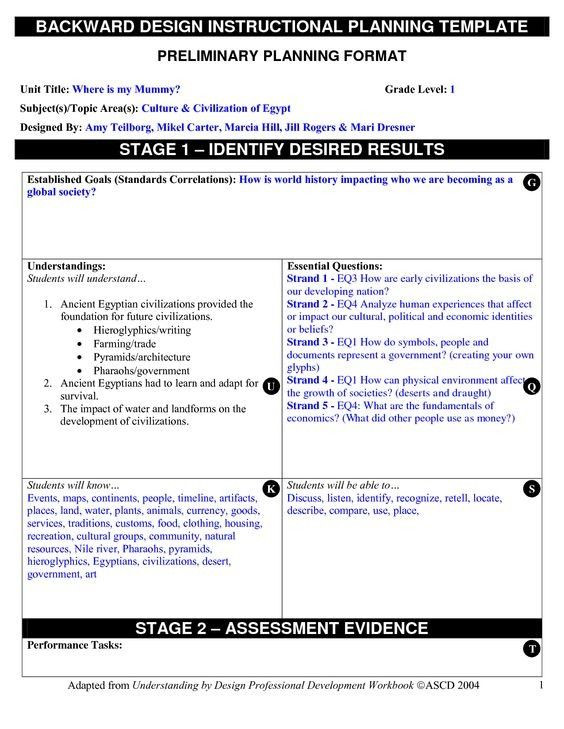Table Of Content

Let’s say a teacher had just finished teaching a place value lesson and was preparing to give her students the exit ticket. She had written a variety of digits on the board and asked the students to create two six-digit numbers, compare them, and then write it out in word form. It was an exit ticket based on the lesson she’d taught previously, and it was appropriate for the lesson, but she didn’t take into consideration the students in the classroom. Most of the students were struggling with reading and writing the number so they couldn’t complete the place value exit ticket.
Backwards Design Step Two: Assessments
When creating your own lesson plans, please refer to your state’s or school’s specific academic standards. Traditional language teaching has often focused on learning and producing language structures and vocabulary through practice-type activities. Do these assessments measure your students skills and content knowledge or just recall and reading comprehension?
Step two: Set assessment methods
For example, even the simple act of having place value strips available to students (even if every student didn’t need them), could have made a big difference in this lesson. Identifying the educational priorities of a lesson or unit deliberately narrows content into a manageable stream. “Understandings” and “Essential Questions” help articulate and communicate the educational priorities.
Time-Consuming Planning Phase
Instructional strategies are the teaching methods by which you present new information to your students. Methods can include teacher-centered approaches like demonstrations or lectures, or student-centered approaches like peer discussion and inquiry-based learning. What do you want students to know or be able to do at the end — explain how cells work? Backward lesson design begins with identifying a specific desired outcome. In the classroom, I found that this resulted in far too much focus on content, rather than having students work and exhibit their own understanding. A natural result of that much content was significant “sage on the stage” time, with lectures replacing what should have been active lessons.

And it is easier to create the final assessment as soon as the goals are made. Traditional assessments were often an exam that included multiple-choice questions and matching (read easy to grade!). Bloom’s Taxonomy is a great tool in helping to identify action verbs appropriate for measurement. An integration of “backwards planning” unit design with the “two-step” lesson planning framework – This article takes a look at the process of backwards planning in a detailed case study of a math class.

Think of your plan as a "course skeleton" rather than as a detailed roadmap. Be prepared to review the columns for alignment, move things around, and update your Course Plan as needed as you progress through each step. Join the more than 100,000 creators who use Teachable to share their knowledge. Easily create and sell courses, coaching, and digital downloads with our powerful yet simple no-code platform. In theory, this will mean that every test your students take is relevant and helpful and shows them exactly what they do and do not need to do in order to pass your course.
Developing a backward design lesson plan step by step
You study standards, learning objectives, or profit margins, then create your lessons and learning materials based on those goals. The backward design approach to curriculum planning enables educators to provide goal-centered instruction. With learning objectives centered, students can appreciate the relevance of the instructional content. The backward design approach for curriculum development applies to individual lesson plans through the backward mapping approach. Traditionally, instructors have applied a forward or content-centered approach to designing lessons, modules, or courses. This approach typically ends with crafting learning objectives to connect the content learned to the assessments.
When developing your course within a Backward Design framework, it is important to map out your course learning objectives, assessments, and learning activities and instructional materials to ensure alignment across the elements. We suggest using CATE’s Course Map Planning Document to guide your progress. Once the assessments are aligned to the intended learning outcomes, the job of in-class instruction becomes much clearer.
Improving How Instructors Teach and Students Learn - University of California San Diego
Improving How Instructors Teach and Students Learn.
Posted: Thu, 20 Oct 2016 07:00:00 GMT [source]
Carmen Common Sense: Best Practices
If they don’t see the relevance of what they’re learning or a direct line between the content of your course and a desirable outcome, they’ll tune it out. Sure, many students will do what you ask anyway, because they want good grades and the benefits that come from them. If you're an Ohio State educator looking for more support with course design, there are a number of resources at your disposal. In addition to browsing our growing repository of teaching topics, we encourage you to explore the following professional development activities.
Uncovering Kentucky history: Ancient American Indian textiles - Kentucky Teacher
Uncovering Kentucky history: Ancient American Indian textiles.
Posted: Thu, 30 Mar 2023 07:00:00 GMT [source]
Unlike backward design, traditional planning begins with the educator who selects a series of learning tasks and then evaluates the resulting learning. This is problematic because learning may be limited to memorizing vocabulary or grammatical structures with little focus on developing language proficiency or using language to explore engaging content. Just like any plan, your initial Backward Design framework may require adjustments. Formative assessment expert Paul Black advocates for continuous improvement through the feedback loop, which involves tweaking the lesson plans based on student performance and other data. Teachers like Carol Ann Tomlinson, known for her work on differentiated instruction, have noted that when students understand what they're working towards, they are often more engaged and motivated. Backward Design’s focus on clear objectives and transparent assessments lets students know what's expected of them, which can enhance their motivation to succeed.
Lastly, the teacher creates an assessment to measure student learning throughout the unit. Now it is time to plan the lessons, determine reading assignments, method of instruction, and other classroom activities to support student learning. With students’ needs in mind, instructors can choose the most appropriate methods to help their students achieve the learning objectives. Finally, instructors create learning activities and instructional materials that align with and support the achievement of the learning objectives.
By being aware of these potential pitfalls, teachers, trainers, and curriculum designers can take steps to mitigate them. You walk away really getting it, able to use what you learned in real life. Well, there's a good chance the person teaching you used Backward Design to plan that awesome learning experience. The big ideas and important understandings are referred to as enduring understandings because these are the ideas that instructors want students to remember sometime after they’ve completed the course. In many classrooms, teachers also have students track the appearance of the moon over the course of a month, so that might be added as well.


No comments:
Post a Comment